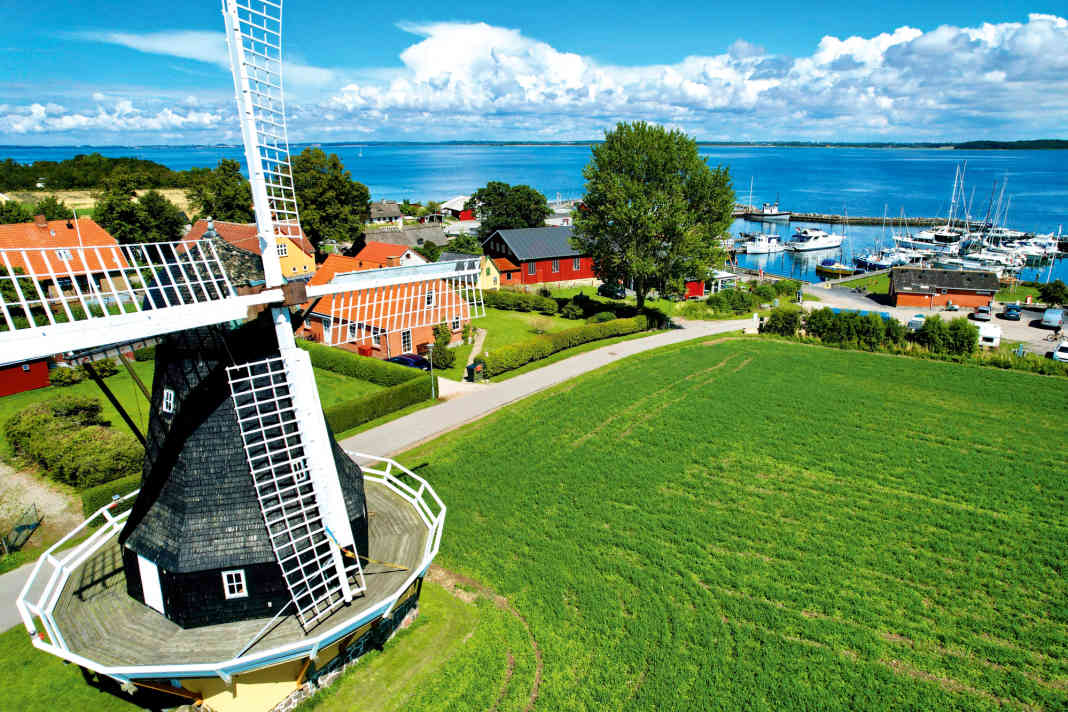





If you ask Baltic skippers about sailing plans for the summer, they often mention destinations such as Copenhagen, Anholt, Sweden's archipelago, Bornholm and, of course, the Danish South Sea and Funen. On the other hand, you rarely hear that someone explicitly wants to go to Småland. This is not because there are not enough beautiful places there. Rather, the location of the area discourages many crews from a longer stay. They usually only use it, if at all, to pass through on their way to more distant and supposedly more attractive coasts and islands. Yet the "fairway" has a lot to offer motorboat crews.
From east to west it stretches a good 35 nautical miles, in a north-south direction it is around 20 nautical miles. Framed by the large islands of Lolland, Falster and Zealand, the Småland fairway forms a clearly enclosed area, even if some smaller sounds, the Grønund and Guldborgsund to the east and south also belong to it.
The Småland fairway can be reached from these sides
It can be reached from three sides: Approaching from the Great Belt around the northern tip of Langeland is easy. The water is sufficiently deep here. Most crews that start somewhere between Flensburg and Fehmarn take this route. The distance is then just over 50 nautical miles. Coming from the south via Guldborgsund, which is around 18 nautical miles long, the journey is a little trickier. This is because it is flat and quite narrow in places. According to the chart, the target depth is 2.1 metres. However, many stones and shallows line the fairway in the sound. Some are even in the middle of the way and have to be navigated around.
Skippers should pay attention to the water level, not just the shallows, as it usually fluctuates around 0.6 metres in the sound. If the wind is persistent from the south-east or south-west, it can drop by up to 0.8 metres.
In addition, current is set: one to two knots in normal weather, up to four knots in stormy weather. The two bridges at Nykøbing and Guldborg, on the other hand, are no obstacle, both open on radio call or flag signal "N", but the clearance height closed for both is at least four metres.
That leaves the crews that set off from the coast of Mecklenburg-Vorpommern. They usually head for the area via Grønsund. This uncomplicated approach between Møn and Falster, for example, is about 40 nautical miles from Warnemünde. Only when the wind is really strong is there a decent current of three to four knots in Grønsund.
You should not miss out on these islands
The five truly idyllic islands with the "ø" in their names are undoubtedly the best known in the Småland fairway: Agersø, Omø, Vejrø, Fejø and Femø. The first three, which lie in the west of the area, are more frequented, as they are also ideal as a stopover for crews travelling in the Great Belt. The latter two, more easterly islands, on the other hand, are very tranquil.
Agersø, famous for its beautiful windmill right by the harbour, is a small but not too sleepy island. There's everything here to make crews happy: a shop, a smokehouse, an ice cream parlour, a restaurant, a bathing jetty and, on top of that, free rental bikes for wonderful tours.
You can find something similar almost everywhere in the area. Everything you need is available, there is something to see here and there, but otherwise nature is the main attraction. It goes hand in hand with an inimitable tranquillity. There is no need to fear the hustle and bustle of Samsø, Anholt, Svendborg and other popular harbours during the season, where it is not uncommon for there to be a mad scramble for free places in the afternoon. You rarely experience this in the Småland fairway. Only the lively Karrebæksminde is an exception in this respect.
The flat south of the district in particular is sparsely populated. Like everywhere else, young people are moving to the larger cities. The flora and fauna benefit from this rural exodus: among other things, the shallow waters are home to very large colonies of birds.
Vejrø is unique in the area: on the private island, which the banker Kim Fournais bought years ago, the harbour has been converted into a luxury resort. This has its price. For boats up to 15 metres in length, the equivalent of 47 euros per night is due, and 74 euros for boats longer than that. For some, a stay here is worth every crown, others shake their heads and turn away - it's a matter of taste.
The same applies to the change from the small islands to the large ones: Lolland, Falster, Møn and Zealand. Here you almost feel like you're on the mainland.
Carefully navigate the Småland fairway
You should navigate carefully in the Småland fairway. In the southern part, the water depth decreases very quickly in many places, and most of the islands are surrounded by pronounced sands and shallows. You should not leave the well-buoyed channels here. As the main axis runs in an east-west direction, the wind is bound to catch you from the front at some point, which can of course be unpleasant if there are waves. However, the distances are all manageable, so just grit your teeth and get through or add another day in the harbour.
In any case, Småland, which has only been called that since the late 20th century, has its charms. It definitely deserves a little more attention when planning a summer cruise than just rushing through it. And even then, it's worth making a stopover or two. We have put together a dozen tips that you should always have in your luggage.
1 Omø
The perfect start to the cruising area for crews travelling over from the Danish South Sea. The pleasant, modern harbour with 100 comfortable berths offers a harbour kiosk including a bread roll service, a playground with hammocks, bicycle hire and, above all, an excellent fish smokehouse. You can sit comfortably in an old shed by the water and watch the ships come in. Don't miss the fish quiche!
You can swim right next to the harbour or on the beach to the west. The island and town are best explored on one of the hire bikes. It is just under two kilometres to the island village, where there is a small shop. If you like, you can cycle on to the bright yellow beacon in the west or take a look at the pretty village church. Otherwise, Omø is pure relaxation. If the harbour is full, which happens in the high season, you can anchor on the eastern shore of the island in a westerly wind. This is also an ideal spot for a swim!
- Further information: www.omoe-net.dk
2 Agersø
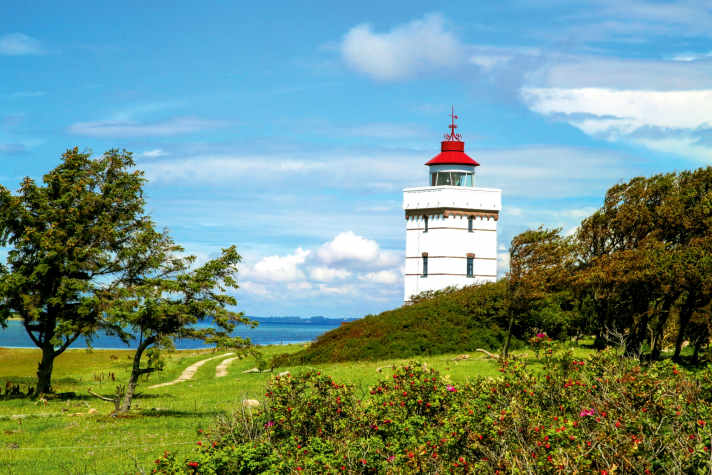
Even from a distance, you can see the village's neatly decorated windmill towering high above the harbour. Like the lighthouse, it serves as a landmark for skippers. Anyone arriving in the high season is greeted warmly by the harbour master and asked about the boat's dimensions. He then allocates a suitable box and takes the lines. If all the boxes are occupied, there is usually still room for yachts along the outer pier in the parcel.
You immediately feel at home in the harbour. There is a kiosk and bistro, a beautiful bathing jetty, free rental bikes, cosy barbecue areas, a fish smokehouse with the most beautiful advertising sign in Denmark and some pretty old houses.
The windmill from 1892 can be visited (Friday to Sunday from 2 to 4 pm). It even grinds on the third weekend in June, Danish Mill Day, and during the harbour festival (last weekend in July). A cycle tour of the island - once all the way around is 14 kilometres - first takes you through the pretty village with its pond. Not far away is the "Agersø Kro", known for its fine cuisine. A cheaper place to eat is the "Havblik" at the harbour. Or you can stock up on fish from the smokehouse for an evening meal on board.
- Further information: www.agersoe.nu
3 Vejrø
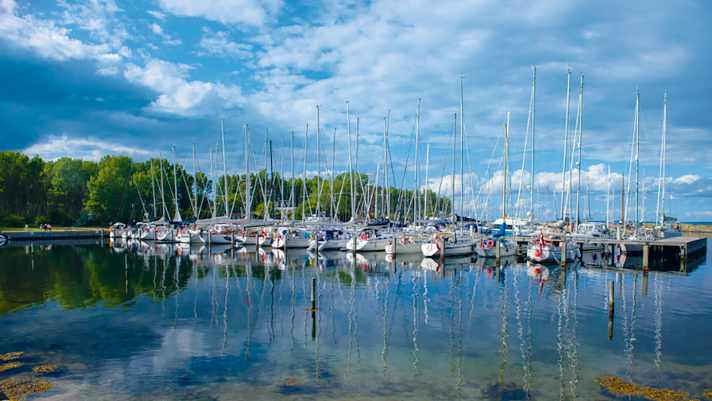
The private island lies in the centre of the Småland fairway. If you are coming from the east from Bøgestrøm and have to tack into a westerly wind, you can stop here after around 30 miles. The approach is easy, jetties and pits are generously dimensioned. The high mooring fee (47 euros up to 15 metres, 74 euros above) includes everything, including the plentiful and probably most luxurious sanitary facilities in Denmark as well as washing machines and dryers.
Firewood for campfires is available free of charge, as are bicycles. However, depending on the wind direction, the fire can give the crews on the berths in the front row a smoky feeling below deck. In this case, it is better to move to a place further away from the shore. The top island restaurant is open Wednesdays to Sundays, and the harbour kiosk serves snacks. Small bathing beach and other bathing spots along the island. Since this year there is also a small speed ferry to Karrebæksminde.
- Further information: vejroe.dk
4 Kragenæs
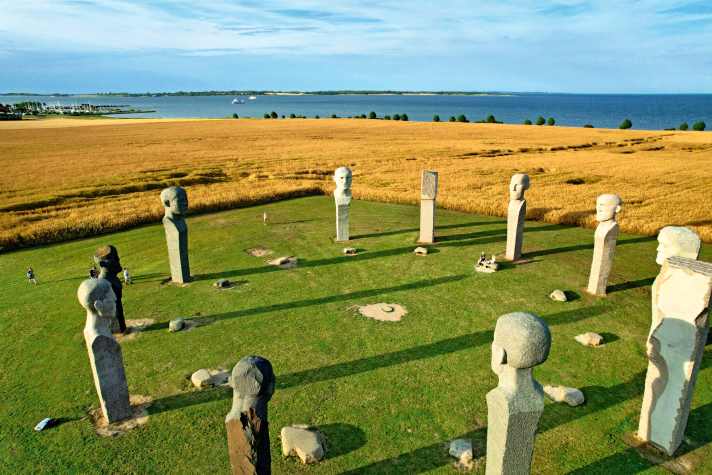
The harbour is also known as the "Stonehenge of the Danes" because Danish artist Thomas Kadziola has been building a stone circle with a diameter of 30 metres not far from the berths for several years. It is formed by twelve granite columns up to eight metres high, the top two metres of which are carved as human heads. Nine of the impressive 30-tonne monuments have already been completed and number ten is in progress. A visit to the installation, which is accompanied by music from a Danish sound artist, is very special indeed. The hill on which the stone circle stands offers a fantastic view of the Småland fairway, with the imposing columns in the foreground.
The location was not chosen at random: One of the most important trade routes of the Bronze Age ran through here, and one of Denmark's largest burial mounds is located nearby. There is no entrance fee to visit. The harbour at Kragenæs, which is part of a campsite, is really cosy. A berth is practically always free. There is a shop with a bakery, snack bar, restaurant, ice cream parlour and bathing jetty. In strong easterly winds there is some swell in the harbour, so the best places are in the second basin to the south. The town itself is tiny and rather uninteresting, Kragenæs lives from its importance as a ferry harbour. But if you want to get to Fejø without travelling across yourself, you can take the ferry across in just a few minutes and explore the island by bike.
- Further information: www.dodekalit.dk, www.marinalystcamp.dk
5 Fejø
The island, which is surrounded by flax, has two harbours; crews usually go to Dybvig in the south. It has space for 20 to 30 boats. If there is a lot of wind from the south, however, the harbour is a little choppy. In the tranquil village, it's worth visiting the café, which also serves hot dishes. Fejø is known as the apple island of the area. Cider and calvados are produced to match the fruit. The latter is expensive and not quite on a par with the French original. But a visit to the salesrooms, where you can also sample the products, is still recommended. Hideaway Vingård, a winery, also offers guided tours and wine tastings (from 3 pm in July). During a cycle tour across the island (approx. 10 kilometres), the "Ny Kro" in the centre of Fejø invites you to eat.
- Further information: www.fejoecider.dk
6 Bandholm
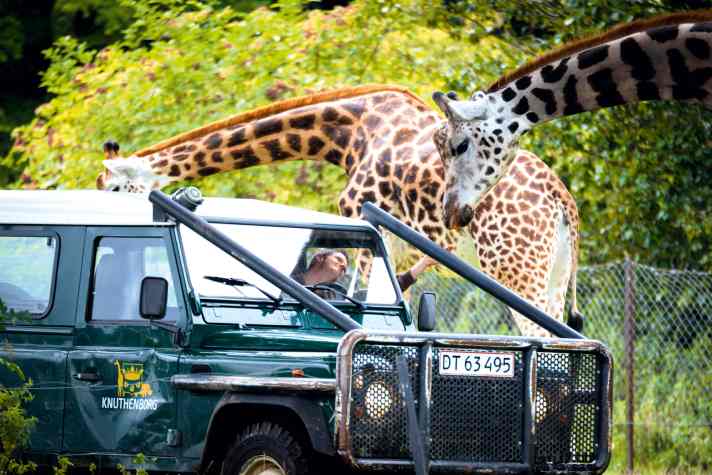
To get straight to the point: The commercial harbour with its large silo is pretty uncharming. The attraction of Bandholm is three kilometres inland. This is where the Knuthenborg Safari Park is located. It is the largest in Northern Europe. Giraffes, rhinos, elephants - there are plenty of wild animals to see here. However, buses no longer run in the park as they used to, and crews can only explore the areas with tame animals on foot. Children will love the various full-size dinosaur replicas that are integrated into the grounds. There is also a large playground with a water slide. Admission costs 30 euros for adults and 13 euros for children, but only if tickets are purchased online in advance. Otherwise it's more expensive! Locomotive fans can travel eight kilometres from Bandholm to Maribo on the historic railway, partly with a steam locomotive. Dates and departure times can be found online.
- Further information: www.knuthenborg.dk, www.museumsbanen.dk
7 Femø
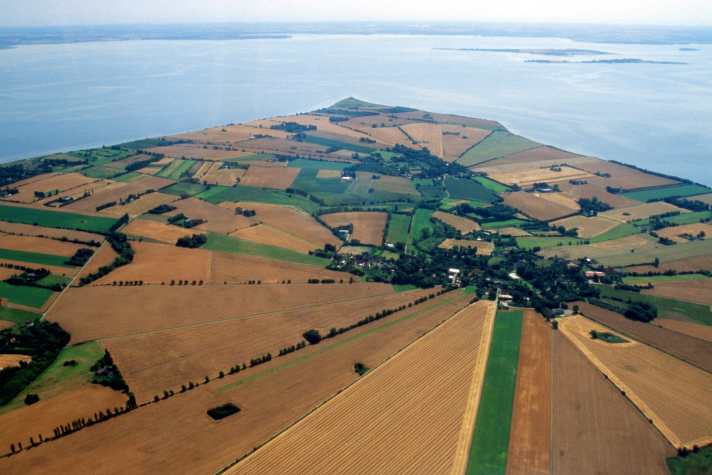
Our neighbours in the north are probably the biggest jazz fans in Europe. There are festivals in many places in summer, and the one on Femø is legendary. For five days at the end of July, the island is turned upside down. Most music fans arrive in caravans or motorhomes. But even the small, recently renovated harbour is bursting at the seams. It's a good thing that there is a good anchorage directly north-west of the harbour entrance - provided the weather is calm. During the rest of the year, things are quiet on the island, which is used for agriculture and is mainly characterised by fruit growing. There is a small, well-stocked shop at the harbour and the "Insel-Kro" with home-style cooking in the island village of Nørreby, just two kilometres away.
- Further information: www.femoekro.dk
8 Karrebæksminde
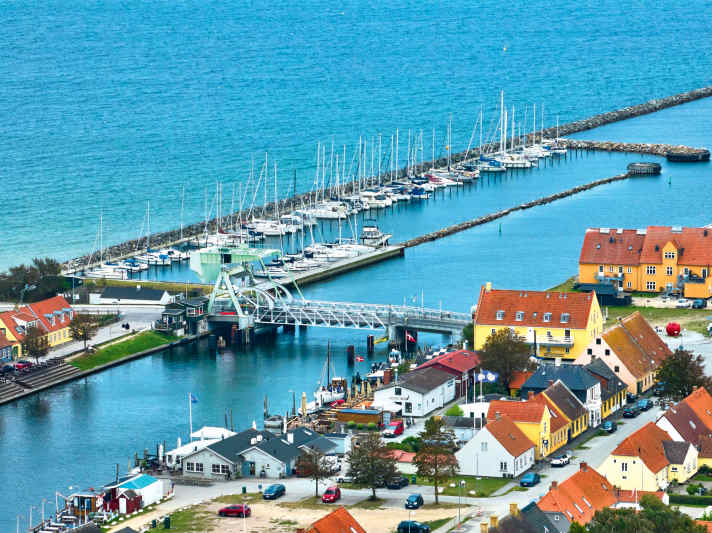
The detour to the north side of the Småland fairway is a must. Karrebæksminde is the summer resort of the town of Næstved, which has 80,000 inhabitants and lies at the very end of the Karrebæksmindefjord. Accordingly, there is a lot going on here in summer. Fortunately, there are three harbours. The first choice is the long harbour on the starboard side of the canal, in front of the bridge. There you are right in the centre of the action. If you prefer things quieter, wait for the Græshoppebroen to open every hour and go to the club harbour behind it. Be careful, there are sometimes two to four knots of cross-current in the canal! There is a lot to discover in Karrebæksminde. Not just the "Grasshopper" bridge, so named because an artist gave it a head and antennae and the green structure looks like a grasshopper. The "Eno" bakery and ice-cream parlour with seating by the canal is also worth a visit. Opposite is the old fishermen's quarter with its smokehouse and restaurants. The castle island of Gavnø is home to a museum and high ropes course, and there is a mini-golf course in the village.
- Further information: www.nsk.dk, www.ganvoe.dk
9 Guldborg
For crews from the Bay of Lübeck, the preferred route into the Småland fairway is via Guldborgsund. This is a partly narrow channel with a narrow fairway that is officially 2.1 metres deep and peppered with shallows. There are two stops along the sound: Falster's largest town, Nykøbing, is halfway along the route. It boasts a medieval centre, a new harbour, good infrastructure and plenty to see. However, seven miles inland plus the return journey is too much for many skippers who are already in the Småland fairway. Guldborg, on the other hand, is the quiet alternative. Here you are idyllically moored in the harbour at the west-facing foot of the bascule bridge. It opens on request via radio (channel 16) from 8 am to 8 pm. The place is rather unspectacular, there is a supermarket and the "Café Lagunen" at the harbour. It is a cosy place to sit and look out over the bridge and the green countryside. There is an anchorage to the north-west of the harbour.
- Further information: www.cafelagunen.dk
10 Vordingborg
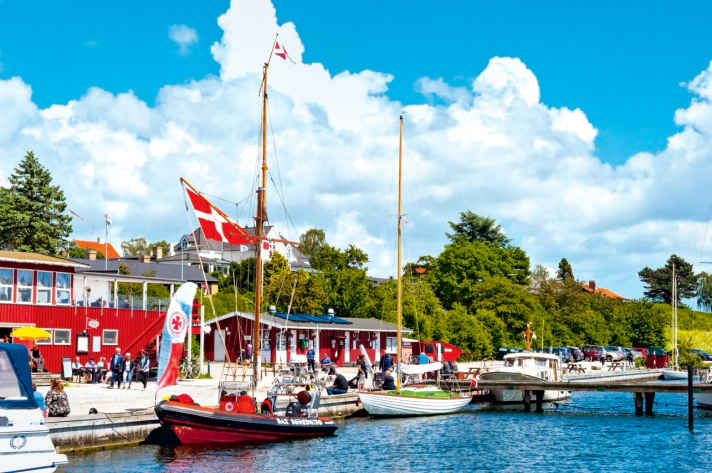
A fairway leads two miles into the very shallow bay, at the end of which the northern harbour is beautifully framed by the town and lots of greenery. The channel tends to silt up, so a little caution is advisable at the edges. Some of the jetties are in much shallower water; only around the jetty heads can you expect water depths of up to two metres. There is a fish restaurant and shop in the harbour. In the 12th century, Vordingborg consisted of a huge castle complex with eight towers, one of the most important in Denmark at the time. Only one tower remains, but the new Danish Castle Museum provides information about the once imposing fortress. In addition to the botanical garden, which is well worth a visit, there are many nice shops in the city as well as the original "Stars" concert hall.
- Further information: www.museerne.dk, www.stars.dk
11 Stubbekøbing

The small town has a marina that was only renovated a few years ago and there is always a place to moor. Crews travelling from the east from Mecklenburg-Vorpommern in particular head for the harbour. Close to the jetties, there is a typical Danish ice cream and snack bar as well as an old slipway where a wooden boat is sometimes being worked on. There is also a small yacht chandlery nearby. He also has the key to the petrol station. In Stubbekøbing, the museum ferry to the islet of Bogø departs regularly during the season; if you like, you can take the ferry across. Or visit the small, lovingly designed Danish Motorbike Museum. It exhibits classic cars from various eras. The pretty village is suffering from a decline in population, but there is still a bakery, a supermarket, two restaurants and a few shops.
- Further information: www.dmcm.dk
12 Nyord
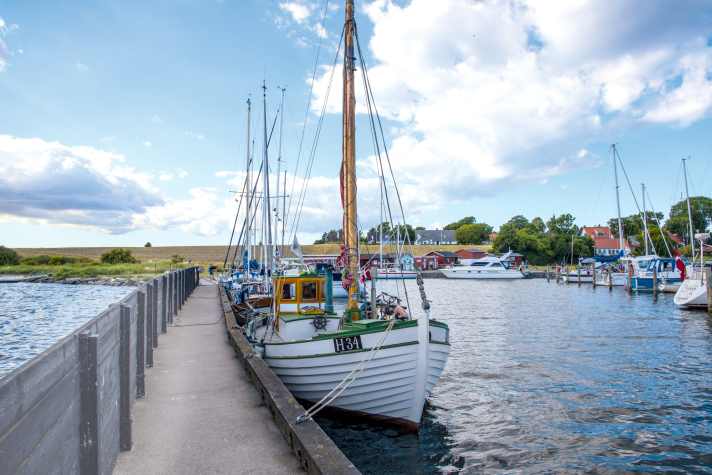
The small island is actually located in Bøgestrøm, just outside the Småland fairway. But it is worth a detour. It used to be an important pilotage point for the journey through the Sound to Copenhagen. The harbour is 2.2 metres deep. The log usually shows less, as the bottom is heavily weeded - don't get nervous! The jetty with its ageing sanitary facilities is a haven of peace. In the summer, the museum mail boat "Røret" commutes to Steege, otherwise there is a huge number of birds chirping here. In the village there is a round church, a restaurant, the great liquor shop "Noorborhandelen" and the gallery "Runas".
- Further information: www.nyord.nu
Service
Charter
No fleets directly in the area. The easiest way for crews to set sail is from Fehmarn, Heiligenhafen or Warnemünde, where the major charter companies such as 1st class yachts, Mola, Ecosail and others have their bases. Or start in Denmark from Kerteminde, where the Danish company Jim Søferie operates a charter base.
Navigation
The entrance to Grønsund, Bøgestrøm and parts of Guldborg Sound have pronounced shallows with a tendency to sand up and shift. You should follow the fairways there carefully. You also have to come to terms with the possible current. In the Guldborg Sound, it sets northwards in strong southerly winds and the water depth drops by up to 0.8 metres. The opposite is true when the wind blows from the north. In Grønsund, you can expect a strong current of four to six knots in strong winds. In northerly and westerly winds, it runs towards the Baltic Sea, in easterly and southerly winds in the opposite direction. Bøgestrøm has a nominal depth of two metres. As there is a lot of seaweed on the bottom, the depth sounder often shows less! A long-lasting easterly wind causes the water level to drop after a rise. Strong westerly gales initially lead to low water, but later to high water. Current current data and water levels for the area at www.dmi.dk/strom.
Harbours & anchorages
Good network of smaller municipal harbours. Price level for ten to twelve metre boats around 20 to 30 euros. Less sheltered anchorages than in the Danish South Sea, for example, often in the shallow water area downwind of the islands.
Tips for going ashore:
- For gourmets: Bandholm Badehotel
- For cyclists: "Fish" cycle tour from Stubbekøbing (19 km)
- For families: Visit to the medieval centre in Nykøbing
You should definitely try it!
- Lunch: Go out for smørrebrød. Often good and cheap offers in the restaurant!
- Guf: the strawberry-sweet icing on every ice cream!
- Award-winning: the tasty Kirsebærvin (cherry wine) and the tangy Krenkerup beer!
Events & Festivals
- 7-8 June: Stubbekøbing Music Festival
- 9 June: Gavnø Classic Car Meeting
- 9-13 July: Vordingborg Festival
- 17-21 July: Fejø Music Festival
- 31. 7-4. 8: Femø Jazz Festival
Charts & Literature
DK sports boat chart set 1, 4, 5, price: 219.90 euros. NV-Verlag set 2, 94.99 euros. Jan Werner: "Denmark 2", 39.90 euros, Delius Klasing Verlag.

